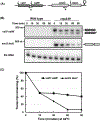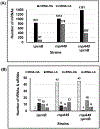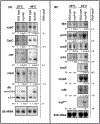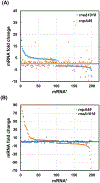Inactivation of RNase P in Escherichia coli significantly changes post-transcriptional RNA metabolism
- PMID: 34486768
- PMCID: PMC8766891
- DOI: 10.1111/mmi.14808
Inactivation of RNase P in Escherichia coli significantly changes post-transcriptional RNA metabolism
Abstract
Ribonuclease P (RNase P), which is required for the 5'-end maturation of tRNAs in every organism, has been shown to play a limited role in other aspects of RNA metabolism in Escherichia coli. Using RNA-sequencing (RNA-seq), we demonstrate that RNase P inactivation affects the abundances of ~46% of the expressed transcripts in E. coli and provide evidence that its essential function is its ability to generate pre-tRNAs from polycistronic tRNA transcripts. The RNA-seq results agreed with the published data and northern blot analyses of 75/83 transcripts (mRNAs, sRNAs, and tRNAs). Changes in transcript abundances in the RNase P mutant also correlated with changes in their half-lives. Inactivating the stringent response did not alter the rnpA49 phenotype. Most notably, increases in the transcript abundances were observed for all genes in the cysteine regulons, multiple toxin-antitoxin modules, and sigma S-controlled genes. Surprisingly, poly(A) polymerase (PAP I) modulated the abundances of ~10% of the transcripts affected by RNase P. A comparison of the transcriptomes of RNase P, RNase E, and RNase III mutants suggests that they affect distinct substrates. Together, our work strongly indicates that RNase P is a major player in all aspects of post-transcriptional RNA metabolism in E. coli.
Keywords: genome-wide RNA-seq; polyadenylation; sRNA; transcriptome.
© 2021 John Wiley & Sons Ltd.
Figures













Similar articles
-
Rho-independent transcription terminators inhibit RNase P processing of the secG leuU and metT tRNA polycistronic transcripts in Escherichia coli.Nucleic Acids Res. 2008 Feb;36(2):364-75. doi: 10.1093/nar/gkm991. Epub 2007 Nov 22. Nucleic Acids Res. 2008. PMID: 18033800 Free PMC article.
-
The rph-1-Encoded Truncated RNase PH Protein Inhibits RNase P Maturation of Pre-tRNAs with Short Leader Sequences in the Absence of RppH.J Bacteriol. 2017 Oct 17;199(22):e00301-17. doi: 10.1128/JB.00301-17. Print 2017 Nov 15. J Bacteriol. 2017. PMID: 28808133 Free PMC article.
-
RNase E plays an essential role in the maturation of Escherichia coli tRNA precursors.RNA. 2002 Jan;8(1):97-109. doi: 10.1017/s1355838202014929. RNA. 2002. PMID: 11871663 Free PMC article.
-
Transfer RNA gene organization and RNase P.Mol Biol Rep. 1995-1996;22(2-3):181-5. doi: 10.1007/BF00988726. Mol Biol Rep. 1995. PMID: 8901508 Review.
-
The multifaceted roles of the RNA processing enzyme ribonuclease III.Indian J Biochem Biophys. 1996 Aug;33(4):253-60. Indian J Biochem Biophys. 1996. PMID: 8936814 Review.
Cited by
-
The DnaJK chaperone of Bacillus subtilis post-transcriptionally regulates gene expression through the YlxR(RnpM)/RNase P complex.mBio. 2025 Mar 12;16(3):e0405324. doi: 10.1128/mbio.04053-24. Epub 2025 Feb 11. mBio. 2025. PMID: 39932325 Free PMC article.
-
Effect of tRNA Maturase Depletion on Levels and Stabilities of Ribosome Assembly Cofactor and Other mRNAs in Bacillus subtilis.Microbiol Spectr. 2023 Feb 22;11(2):e0513422. doi: 10.1128/spectrum.05134-22. Online ahead of print. Microbiol Spectr. 2023. PMID: 36840557 Free PMC article.
-
YeeD is an essential partner for YeeE-mediated thiosulfate uptake in bacteria and regulates thiosulfate ion decomposition.PLoS Biol. 2024 Apr 24;22(4):e3002601. doi: 10.1371/journal.pbio.3002601. eCollection 2024 Apr. PLoS Biol. 2024. PMID: 38656967 Free PMC article.
-
High-Resolution Small RNAs Landscape Provides Insights into Alkane Adaptation in the Marine Alkane-Degrader Alcanivorax dieselolei B-5.Int J Mol Sci. 2022 Dec 15;23(24):15995. doi: 10.3390/ijms232415995. Int J Mol Sci. 2022. PMID: 36555635 Free PMC article.
-
Highly efficient multiplex base editing: One-shot deactivation of eight genes in Shewanella oneidensis MR-1.Synth Syst Biotechnol. 2022 Oct 13;8(1):1-10. doi: 10.1016/j.synbio.2022.09.005. eCollection 2023 Mar. Synth Syst Biotechnol. 2022. PMID: 36313217 Free PMC article.
References
-
- Alifano P, Rivellini F, Piscitelli C, Arraiano CM, Bruni CB, and Carlomagno MS (1994). Ribonuclease E provides substrates for ribonuclease P-dependent processing of a polycistronic mRNA. Genes Dev 8, 3021–3031. - PubMed
-
- Altuvia S, Weinstein-Fischer D, Zhang A, Postow L, and Storz G (1997). A small, stable RNA induced by oxidative stress: role as a pleiotropic regulator and antimutator. Cell 90, 43–53. - PubMed
-
- August J, Ortiz PJ, and Hurwitz J (1962). Ribonucleic acid-dependent ribonucleotide incorporation. I. Purification and properties of the enzyme. J Biol Chem 237, 3786–3793. - PubMed
Publication types
MeSH terms
Substances
Grants and funding
LinkOut - more resources
Full Text Sources
Molecular Biology Databases
Research Materials

